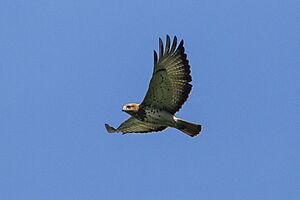Red-necked buzzard facts for kids
Quick facts for kids Red-necked buzzard |
|
|---|---|
 |
|
| Conservation status | |
| Scientific classification |
The red-necked buzzard (Buteo auguralis) is a cool bird of prey. It's also called the African red-tailed buzzard. This type of buzzard lives in western and central Africa. It belongs to the Accipitridae family, which includes many birds of prey like eagles and hawks.
Contents
What It Looks Like
The red-necked buzzard is a medium-sized bird. It has a special reddish-brown color on its neck. This color goes up over its head and down onto its upper back. Most of its upper body is dark, almost black. Its upper tail feathers are also reddish-brown, with a black stripe near the end.
Its belly and chest are mostly white. It has a dark throat and dark spots along its sides. Young buzzards look a lot like the adults. However, their upper parts are more brownish. Their underparts are creamy instead of bright white, and they don't have the dark throat.
Where It Lives and Moves
You can find the red-necked buzzard in a wide area of Africa. This area stretches from Mauritania in the west, south to Liberia. Then it goes east all the way to Ethiopia and Uganda. It also lives along the Gulf of Guinea coast. This includes countries like Gabon and the Democratic Republic of Congo, and even parts of north-eastern Angola.
Some red-necked buzzards move around, while others stay in one place. The ones living in the northern parts of Africa might move completely. They leave the grassy savanna areas when the rainy season ends. They spend the dry season further south, near the edge of the main forest areas.
Its Home (Habitat)
The red-necked buzzard likes to live where forests meet open spaces. This includes the edges of forests and clearings inside them. It can be found in both old, untouched forests and newer, regrown ones. It also lives in farm areas. However, it usually avoids the main, dense lowland rainforests. You can find these buzzards up to an altitude of about 2,500 meters (about 8,200 feet) above sea level.
How It Hunts and What It Eats
The red-necked buzzard is a clever hunter. It usually waits quietly on a high perch, like a tree branch. From there, it watches the ground carefully for food. When it spots something, it swoops down quickly to catch its prey.
This buzzard eats many different small animals. It's not picky! Its diet includes:
- Rodents (like mice and rats)
- Other birds
- Lizards
- Snakes
- Arthropods (like insects)
- Especially termites
Reproduction and Life Cycle
Red-necked buzzards build their nests out of sticks. They usually place these nests high up in the fork of a large forest tree. Sometimes, they build nests on cliff ledges or even on tall pylons (like electricity poles). A pair of buzzards might use the same nest spot year after year.
They usually lay one or two eggs at a time. In the northern parts of their home range, they probably lay eggs between November and January. Further south, they lay eggs later in the year. For example, young buzzards have been seen in nests in August in the southern areas.


